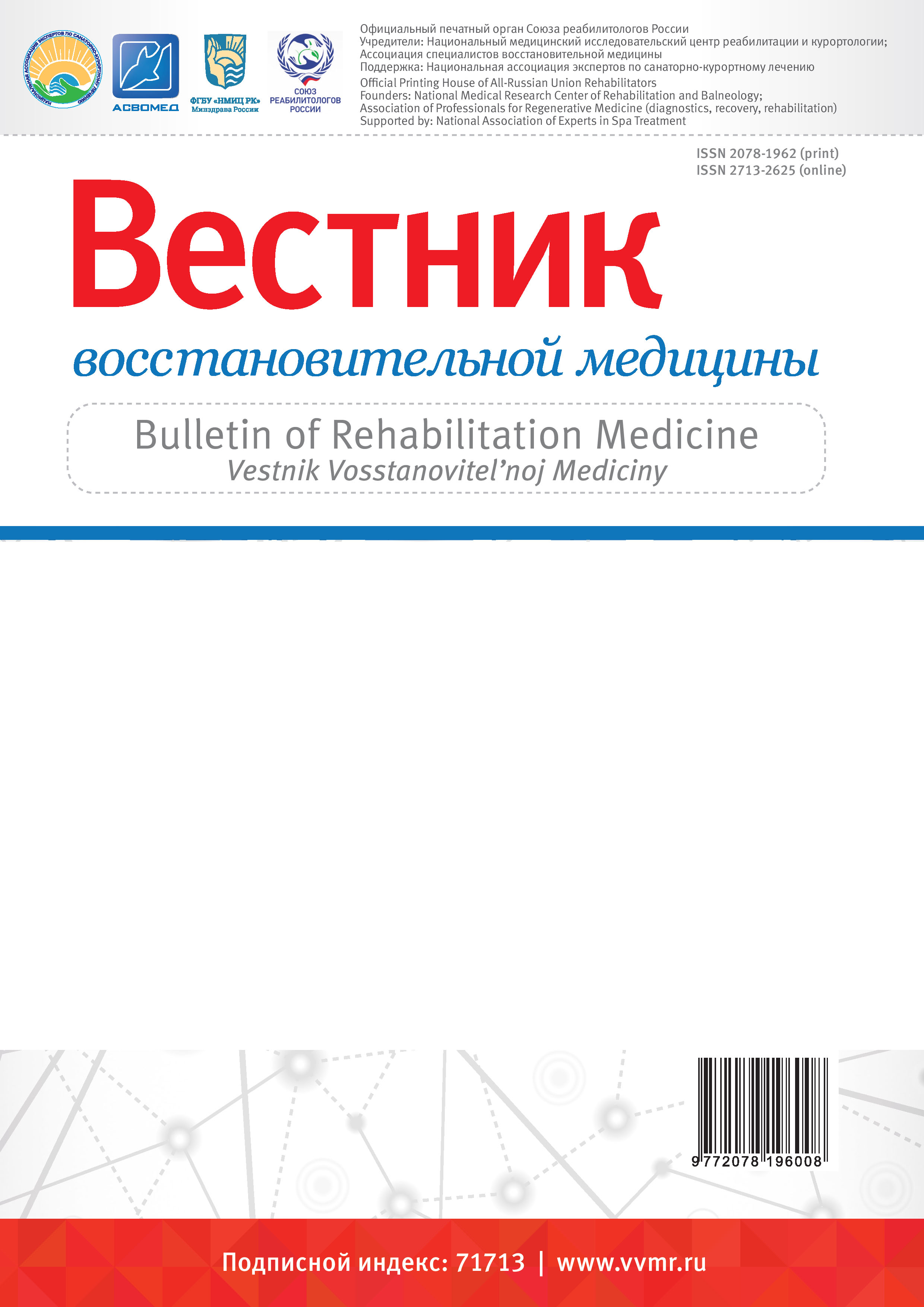Московский государственный университет им. М.В. Ломоносова, Москва, Россия
AIM. To develop a methodology for the physical rehabilitation of elderly men with sarcopenia taking into account individual characteristics and somatotype. MATERIAL AND METHODS. A comprehensive anatomical-anthropological and instrumental (bioimpedance analysis) examination of 198 men aged 61 to 75 years (68±3.27 years) suffering from sarcopenia was carried out. The patients were divided into two groups depending on the method of physical rehabilitation. The duration of the rehabilitation programs was 12 weeks. The obtained results were compared with the indices of medical and biological state of 37 elderly men without sarcopenia signs (Group III). Somatotyping of all study participants was carried out according to the classification proposed by V.M. Chernorutsky. RESULTS AND DISCUSSION. Normosthenic patients predominated (group I – 46%, group II – 47%, group III – 67%), astenics in groups I and II amounted to 27.5%, in group III – 25%. The number of hypersthenic in group III was 8%, that was 17% and 19% less than in groups I and II, respectively. After 12 weeks no significant differences between groups II and III in the main indices had been revealed.The body mass index of men of group I was 1.04 and 1.07 times lower than in groups II and III, respectively. The difference in carpal strength between groups I and III was 4.9±1.34 kg (15.41%; P < 0.05), while the difference in that index between groups II and III (1.88 kg or 5.9%) were reliably insignificant (P > 0.05). The complete absence of signs of disease was found in 29 patients (32.5%) in group II and in 16 patients (14.7%) in group I, the difference between the groups being 17.9%. CONCLUSION. Sarcopenia is characteristic of hypersthenic males. Somatotyping is an accessible rapid diagnostic tool that allows us to identify groups of patients prone to sarcopenia.
sarcopenia, physical medicine and rehabilitation, somatotypes, body composition, aging, quality of life
1. Norman K., Otten L. Financial impact of sarcopenia or low muscle mass - A short review. Clinical Nutrition. 2019; 38(4): 1489-1495. https://doi.org/10.1016/j.clnu.2018.09.026
2. Sanchez-Rodriguez D., Marco E., Cruz-Jentoft A.J. Defining sarcopenia: some caveats and challenges. Current Opinion in Clinical Nutrition and Metabolic Care. 2020; 23(2): 127-132. https://doi.org/10.1097/MCO.0000000000000621
3. Chen Z., Li W. Y., Ho M., Chau P. H. The Prevalence of Sarcopenia in Chinese Older Adults: Meta-Analysis and Meta-Regression. Nutrients. 2021; 13(5): 1441. https://doi.org/10.3390/nu13051441
4. Dodds R.M., Granic A., Robinson S.M., Sayer A.A. Sarcopenia, long-term conditions, and multimorbidity: findings from UK Biobank participants. Journal of Cachexia, Sarcopenia and Muscle. 2020; 11(1): 62-68. https://doi.org/10.1002/jcsm.12503
5. Bocharova K.A., Rukavishnikova S.A., Osipov K.V., Shadrin K.A., Odegnal A.A., Kurnosenko V.Yu. Sarkopeniya v sisteme dolgovremennogo uhoda. Sovremennye problemy zdravoohraneniya i medicinskoy statistiki. 2021; (2): 12-26. https://doi.org/10.24412/2312-2935-2021-2-12-26
6. Chang C.F., Yeh Y.L., Chang H.Y., Tsai S.H., Wang J.Y. Prevalence and Risk Factors of Sarcopenia among Older Adults Aged ≥65 Years Admitted to Daycare Centers of Taiwan: Using AWGS 2019 Guidelines. International Journal of Environmental Research and Public Health. 2021; 18(16): 8299. https://doi.org/10.3390/ijerph18168299
7. Trajanoska K., Schoufour J.D., Darweesh S.K., Benz E., Medina-Gomez C., Alferink L.J., Lahousse L., Brusselle G., Stricker B., Darwish Murad S., Zillikens M.C., Uitterlinden A.G., Ikram M.A., Franco O.H., Rivadeneira F. Sarcopenia and Its Clinical Correlates in the General Population: The Rotterdam Study. Journal of Bone and Mineral Research. 2018; 33(7): 1209-1218. https://doi.org/10.1002/jbmr.3416
8. Pleschev I.E., Achkasov E.E., Nikolenko V.N., Shkrebko A.N. Sarkopeniya: sovremennye podhody k diagnostike i reabilitacii. Sovremennye problemy nauki i obrazovaniya. 2022; (1). https://doi.org/10.17513/spno.31443
9. Ramirez E., Salas R., Bouzas C., Pastor R., Tur J.A. Comparison between Original and Reviewed Consensus of European Working Group on Sar- copenia in Older People: A Probabilistic Cross-Sectional Survey among Community-Dwelling Older People. Gerontology. 2022; 68(8): 869-876. https://doi.org/10.1159/000519304
10. Wong H.J., Harith S., Lua P.L., Ibrahim K.A. Possible Sarcopenia and Its Association with Nutritional Status, Dietary Intakes, Physical Activity and Health-Re- lated Quality of Life among Older Stroke Survivors. Annals of Geriatric Medicine and Research. 2022; 26(2): 162-174. https://doi.org/10.4235/agmr.22.0033
11. Fernandes L.V., Paiva A., Silva A., de Castro I.C., Santiago A.F., de Oliveira E.P., Porto L. Prevalence of sarcopenia according to EWGSOP1 and EWGSOP2 in older adults and their associations with unfavorable health outcomes: a systematic review. Aging Clinical and Experimental Research. 2022; 34(3): 505-514. https://doi.org/10.1007/s40520-021-01951-7
12. Goisser S., Kob R., Sieber C.C., Bauer J.M. Diagnosis and therapy of sarcopenia-an update. Der Internist. 2019; 60(2): 141-148. https://doi.org/10.1007/s00108-018-0551-x
13. Cruz-Jentoft A.J., Bahat G., Bauer J., Boirie Y., Bruyère O., Cederholm T., Cooper C., Landi F., Rolland Y., Sayer A.A., Schneider S.M., Sieber C.C., Topinkova E., Vandewoude M., Visser M., Zamboni M. Writing Group for the European Working Group on Sarcopenia in Older People 2 (EWGSOP2), and the Extended Group for EWGSOP2. Sarcopenia: revised European consensus on definition and diagnosis. Age and Ageing. 2019; 48(1): 16-31. https://doi.org/10.1093/ageing/afy169
14. Tkacheva O.N., Kotovskaya Yu.V., Runihina N.K., Frolova E.V., Naumov A.V., Vorob'eva N.M., Ostapenko V.S., Mhitaryan E.A., Sharashkina N.V., Tyuhmenev E.A., Pereverzev A.P., Dudinskaya E.N. Klinicheskie rekomendacii «starcheskaya asteniya». Chast' 2. Rossiyskiy zhurnal geriatricheskoy mediciny. 2020; (2): 115-130. https://doi.org/10.37586/2686-8636-2-2020-115-130
15. Hita-Contreras F., Bueno-Notivol J., Martínez-Amat A., Cruz-Díaz D., Hernandez A.V., Pérez-López F.R. Effect of exercise alone or combined with dietary supplements on anthropometric and physical performance measures in community-dwelling elderly people with sarcopenic obesity: A meta-analysis of randomized controlled trials. Maturitas. 2018; (116): 24-35. https://doi.org/10.1016/j.maturitas.2018.07.007
16. Margazin V.A., Gasnburgskiy A.N., Noskov S.M. LFK pri zabolevaniyah sustavov. Sankt-Petereburg. Speclit. 2022: 271 s.
17. Gonzalez M.C., Barbosa-Silva T.G., Heymsfield S.B. Bioelectrical impedance analysis in the assessment of sarcopenia. Current Opinion in Clinical Nutrition and Metabolic Care. 2018; 21(5): 366-374. https://doi.org/10.1097/MCO.0000000000000496
18. Li M., Kong Y., Chen H., Chu A., Song G., Cui Y. Accuracy and prognostic ability of the SARC-F questionnaire and Ishii's score in the screening of sarcopenia in geriatric inpatients. Brazilian Journal of Medical and Biological Research. 2019; 52(9): e8204. https://doi.org/10.1590/1414-431X20198204
19. Bauer J., Morley J.E., Schols A., Ferrucci L., Cruz-Jentoft A.J., Dent E., Baracos V.E., Crawford J.A., Doehner W., Heymsfield S.B., Jatoi A., Kalantar-Zadeh K., Lainscak M., Landi F., Laviano A., Mancuso M., Muscaritoli M., Prado C.M., Strasser F., von Haehling S., Anker S. D. Sarcopenia: A Time for Action. An SCWD Position Paper. Journal of Cachexia, Sarcopenia and Muscle. 2019; 10(5): 956-961. https://doi.org/10.1002/jcsm.12483
20. Kukes V.G., Nikolenko V.N., Pavlov C.S., Zharikova T.S., Marinin V.F., Gridin L.A. The correlation of somatotype of person with the development and course of various diseases: results of Russian research. Russian Open Medical Journal. 2018; (7): e0301. https://doi.org/10.15275/rusomj.2018.0301
21. Nikolenko V.N., Oganesyan M.V., Vovkogon A.D., Cao Y., Churganova A.A., Zolotareva M.A., Achkasov E.E., Sankova M.V., Rizaeva N.A., Sinelnikov M.Y. Morphological signs of connective tissue dysplasia as predictors of frequent post-exercise musculoskeletal disorders. BMC Musculoskeletal Dis- orders. 2020; 21(1): 660 p. https://doi.org/10.1186/s12891-020-03698-0
22. Treacy D., Hassett L., Schurr K., Fairhall N.J., Cameron I.D., Sherrington C. Mobility training for increasing mobility and functioning in older people with frailty. The Cochrane Database of Systematic Reviews. 2022; (6): CD010494. https://doi.org/10.1002/14651858.CD010494.pub2
23. Chen J., Xue X., Xu J., Zeng J., Xu F. Emerging Trends and Hotspots in Tai Chi Fall Prevention: Analysis and Visualization. International Journal of Environmental Research and Public Health. 2022; 19(14): 8326. https://doi.org/10.3390/ijerph19148326
24. Papadopoulou S.K. Sarcopenia: A Contemporary Health Problem among Older Adult Populations. Nutrients. 2020; 12(5): 1293. https://doi.org/10.3390/nu12051293
25. Trouwborst I., Verreijen A., Memelink R., Massanet P., Boirie Y., Weijs P., Tieland M. Exercise and Nutrition Strategies to Counteract Sarcopenic Obesity. Nutrients. 2018; 10(5): 605. https://doi.org/10.3390/nu10050605
26. Cook S.B., Cleary, C.J. Progression of Blood Flow Restricted Resistance Training in Older Adults at Risk of Mobility Limitations. Frontiers in Physiology. 2019; (10): 738. https://doi.org/10.3389/fphys.2019.00738
27. Coelho-Junior H.J., Calvani R., Azzolino D., Picca A., Tosato M., Landi F., Cesari M., Marzetti, E. Protein Intake and Sarcopenia in Older Adults: A Systematic Review and Meta-Analysis. International Journal of Environmental Research and Public Health. 2022; 19(14): 8718. https://doi.org/10.3390/ijerph19148718
28. Safonova Yu.A., Zotkin E.G. Chastota sarkopenii v starshih vozrastnyh gruppah: ocenka diagnosticheskih kriteriev. Nauchno-prakticheskaya revmatologiya. 2020; 58(2): 147-153. https://doi.org/10.14412/1995-4484-2020-147-153
29. Wallengren O., Bosaeus I., Frändin K., Lissner L., Falk Erhag H., Wetterberg H., Rydberg Sterner T., Rydén L., Rothenberg E., Skoog I. Comparison of the 2010 and 2019 diagnostic criteria for sarcopenia by the European Working Group on Sarcopenia in Older People (EWGSOP) in two cohorts of Swedish older adults. BMC Geriatrics. 2021; 21(1): 600. https://doi.org/10.1186/s12877-021-02533-y






